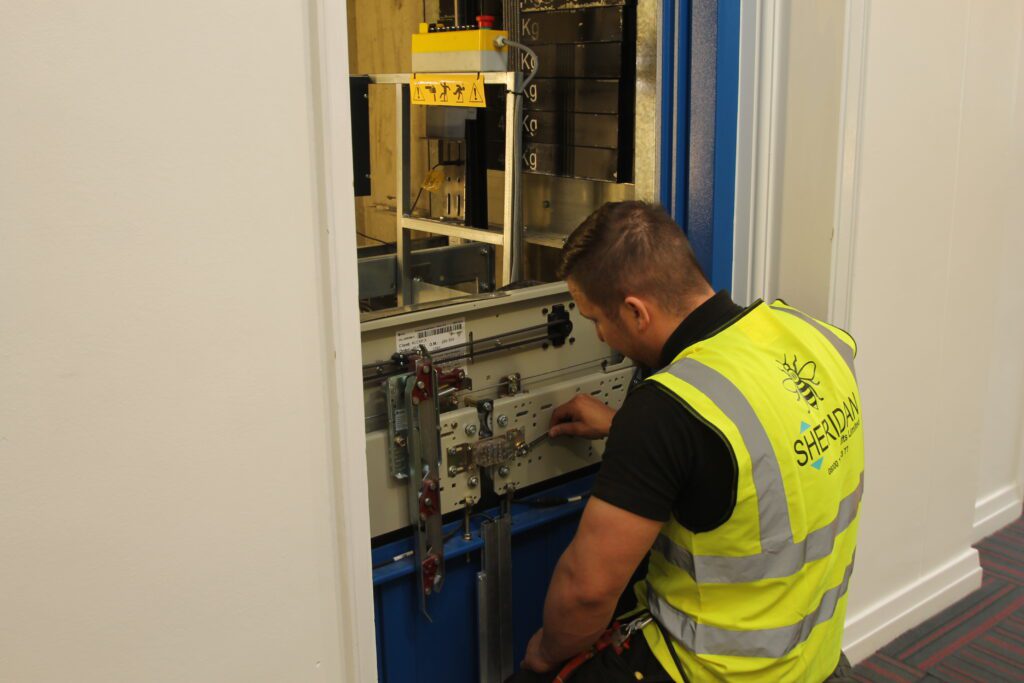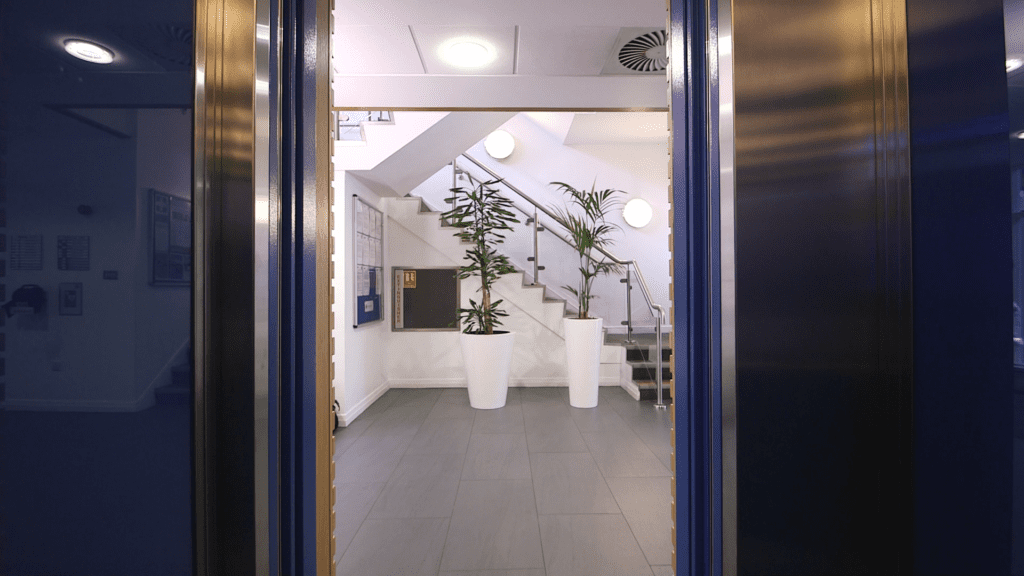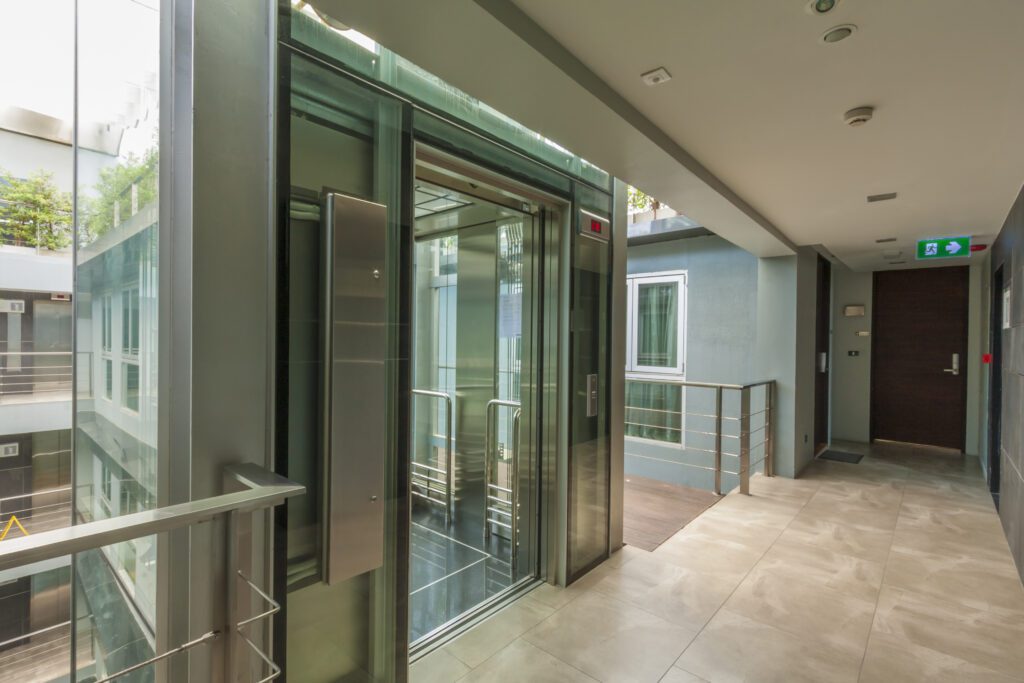If you’ve been around our site for long, you know that, as the nation’s leading lift experts, we’re advocates for lift maintenance as a preventative measure. Now, we are going to go through the types of lift maintenance you can get.
Lifts are vital for vertical transportation, optimising accessibility and efficiency within buildings. However, to ensure their smooth operation and safety, regular maintenance is paramount.
In this blog, we delve into the different types of lift maintenance and what benefits they hold. From routine inspections to preventive measures and regulatory compliance, here are some of the main topics we’ll cover:
- Types of Lift Maintenance
- How Do You Know If Your Lift Needs Maintenance?
- Lift Maintenance Checklist
- How Often Should a Lift Be Inspected?
- What’s Included in Our Lift Maintenance Package?

The 4 Main Types of Lift Maintenance
Amongst our other lift services, lift maintenance is one of the main services that we recommend here at Sheridan Lifts.
Why? Like anything, it is better to fix something before the fault escalates. Lift breakdowns can be costly and inconvenient for occupants and owners alike. They slow down operations and the smooth running of your building – that’s why it is better to address the lift problem before you end up having no choice but to get an emergency call-out.
Preventive Maintenance
The first type of lift maintenance is preventive maintenance, which involves performing routine maintenance at scheduled intervals to prevent equipment failure. This type of maintenance is performed based on a predetermined schedule and is meant to keep the equipment in optimum working condition.
In the case of Sheridan Lifts, we offer 3 different maintenance packages, which range between 4 and 12 yearly visits. By performing preventative maintenance, equipment operators can reduce the likelihood of breakdowns, improve the asset’s lifespan, and save on repair costs.
Examples of preventive maintenance include:
- Lubrication of moving parts
- Cleaning
- Equipment inspections
Corrective Maintenance
Corrective maintenance is performed after an asset has already failed. This type of maintenance is typically reactive and requires immediate attention to restore the equipment to its normal operating conditions. Corrective maintenance is usually more expensive since it involves repairing or replacing parts that have already failed.
When choosing maintenance packages, our Sheridan Comprehensive includes the cost of parts up to £350, which saves you money in the long term.
A common example of corrective maintenance is repairing a machine after detecting a major fault or after a breakdown that required emergency repair.
Corrective maintenance is beneficial because it is cost-effective when compared to conducting frequent repairs or replacing equipment frequently. For example, it can be more cost-effective to replace a single faulty component of a system rather than replacing the entire system or equipment. This maintenance strategy is also ideal for situations where preventive maintenance is not feasible due to cost constraints or time limitations.
Regulatory Compliance Maintenance
Regulatory compliance maintenance for lifts ensures that your lifts or elevators comply with the applicable safety regulations and standards. It usually involves inspection and testing to verify your lift’s compliance alongside a set of codes – having passed the checks, the assurance being that your lifts are safe for use.
This type of lift maintenance considers regulations set by local regulatory authorities, government agencies, and relevant industry standards organisations. These regulations and standards may differ across countries and regions, but they generally focus on aspects such as design, installation, operation, maintenance, and safety features of lifts.
Lift Refurbishment and Upgrades
Lift refurbishment, also known as lift modernisation, refers to the process of upgrading or renovating an existing lift system to improve its performance, functionality, safety, aesthetics, or energy efficiency. Lift refurbishment aims to enhance the overall user experience, extend the lifespan of the lift, and bring it up to modern standards and technologies.
Here are some common aspects of lift refurbishment:
- Mechanical Components: Lift refurbishment often involves upgrading or replacing mechanical components such as motors, gearboxes, pulleys, and drive systems.
- Electrical System: The electrical system of a lift may be modernised by replacing outdated control panels, buttons, and indicators with more advanced and user-friendly ones.
- Safety Features: Refurbishing lifts often includes enhancing or adding safety features to meet current regulations and standards.
- Interior Design and Aesthetics: Lift refurbishment can include updating the lift’s interior design, including walls, ceilings, flooring, lighting, and mirrors, in order to create a modern and appealing atmosphere for passengers.
- Accessibility and Compliance: Refurbishment projects may focus on improving accessibility features for people with disabilities. This can involve installing ramps, braille buttons, audible announcements, and ensuring compliance with relevant accessibility standards.
- Energy Efficiency: Lift refurbishment may include implementing energy-efficient technologies, such as LED lighting, regenerative drives, or standby mode operation to reduce energy consumption and operating costs.
- Upgrading Controls and Systems: Refurbishing lifts often involves upgrading control systems, replacing outdated controllers with more advanced ones, and integrating modern technology for improved performance, monitoring, and remote diagnostics.
The scope and extent of lift refurbishment can vary depending on factors such as the lift’s age, condition, usage, budget, and specific requirements. It is important to consult with lift refurbishment professionals such as Sheridan Lifts to assess the existing lift system and determine the most suitable refurbishment options. Contact us today to learn more.

How Do You Know If Your Lift Needs Maintenance?
Now that you’ve learnt about the types of lift maintenance you can get, an important question arises – ‘How do you know when your lift needs maintenance?’
While regular maintenance is the way forward, your engineer will know what the lift needs as time goes on and will make adjustments to prevent your lift from declining prematurely. If you don’t get regular maintenance checkups, your lift will likely start showing signs that it needs lift maintenance in time.
Signs that your lift needs maintenance include:
- Unusual noises or vibrations
- Slow or inconsistent performance
- Jerky movements or rough stops
- Faulty or inconsistent lighting
- Error codes or malfunctions
- Unexplained power fluctuations
Lift Maintenance Checklist
Keeping a comprehensive report of your lift’s status is a helpful way to make sure you’re on top of your lift’s maintenance needs. Having a checklist of areas you can be on the lookout for is a good way to make sure nothing gets past you.
We recommend that you don’t attempt to fix these problems yourself. The lift maintenance checklist is here to guide you through the common elements in a lift that may have issues. Make a note of them for when your maintenance engineers are on site.
- Start with a visual inspection:
- Check for any physical damage or signs of wear on the lift components, including cables, pulleys, rails, and doors.
- Ensure that all safety devices, such as limit switches, emergency stop buttons, and interlocks, are in place and functioning properly.
- Inspect the condition of the control panel, buttons, and indicators.
- Don’t forget the mechanical components:
- Lubricate moving parts as per the manufacturer’s recommendations.
- Inspect bolts and fasteners.
- Check for any abnormal noise or vibration during operation.
- Examine the condition of the drive system, including motors, gearboxes, and brakes.
- Inspect the electrical system:
- Test safety sensors, such as door sensors and overload sensors.
- Verify the proper functioning of lighting and emergency lighting systems.
- Carefully inspect electrical connections.
- Check the condition of wiring, cables, and insulation for any signs of damage.
- Check the safety features:
- Test the emergency stop button and ensure it halts the lift immediately.
- Test and reset fire alarm integrations and emergency evacuation procedures.
- Review the control systems:
- Inspect the control panel for any error codes or malfunctions
- Test all control buttons and indicators
- Observe all doors and entrances:
- Inspect the condition of the doors, including their opening and closing mechanisms.
- Check the alignment of the doors with the floor.
- Lastly, keep maintenance records:
- Keep a log of all maintenance activities, including repairs, replacements, and inspections.
- Record any issues found during the inspection and the actions taken to address them.
If your lift is showing any signs of a problem, it’s important you contact a qualified lift engineer immediately. Don’t try to solve the problem yourself, as it may lead to serious injury or worsening of the issue. Get in touch today.
How Often Should a Lift Be Inspected?
The general recommendation is that you should have your lift inspected at least every 6 months. But this is dependent on the type of inspection. For regular routine inspections, it is recommended that you should get an inspection on a monthly or quarterly basis. These inspections are intended to identify any visible issues or signs of wear and tear. They may include visual checks, lubrication, and basic functional tests. The specific frequency may depend on factors such as lift usage, environment, and local regulations.
A thorough inspection is a legal third-party or government inspection that ensures your lift complies with the legal safety standards for your area. A thorough inspection needs to happen every 6 months and usually involves a more detailed examination of the lift’s mechanical, electrical, and safety components.
If you think your lift is due for an inspection, our lift engineers are stationed across the UK and can be on-site in 4 hours if needed.

What’s Included in Our Lift Maintenance Package?
Instead of offering one big lift maintenance package for everyone, at Sheridan Lifts, we offer unique packages suited for any maintenance needs level.
If your lift doesn’t require as much maintenance because it is in good condition and has low usage, then the Sheridan Standard package might be for you.
If your lift requires more visits and repairs, then you can opt for the Sheridan Comprehensive or Sheridan Premium.
Let’s break down what the differences are:
Sheridan Standard
The Sheridan Standard package is our basic maintenance package. It’s great for those with lifts that don’t have high usage rates or as many lifts to cover.
Our Sheridan Standard maintenance package comes with a choice of 4, 6, or 12 visits per year from one of our experienced lift engineers. The engineer will ensure that your lift is legally compliant and in line with local legislation.
Although emergency repair costs are not included with this package, you will still have access to our 24-hour helpline with a 1-hour entrapment response time guaranteed and a 4-hour repair response time as standard.
Sheridan Comprehensive
If you need a more complete service, then the Sheridan Comprehensive package is the maintenance plan for you – this all-inclusive lift maintenance package is designed to take care of all your regular servicing needs and more.
It includes everything that the Sheridan Standard offers plus:
- 6 to 12 yearly visits
- On-site service reports
- Complete risk assessments
- Part replacements covered up to £350
- Assigned personal key account manager
Sheridan Premium
Our Sheridan Premium package is ideal for those that need a complete hands-on maintenance approach. It includes all of the things that you’d find with the Sheridan Comprehensive, as well as the choice of 4, 6 and 12 visits similar to the Sheridan Standard package.
It also includes callouts to lift breakdowns during peak business hours at no extra cost.
Unsure Which Type of Lift Maintenance You Need? We’re Here to Help
Lift maintenance plays a critical role in ensuring the reliable and safe operations of lifts. Routine inspections are the foundation of lift maintenance, allowing for the early detection of issues and signs of wear.
Incorporating preventive maintenance into your lift maintenance strategy helps to mitigate potential problems and minimise downtime, resulting in improved lift performance and increased longevity.
With so many lift faults that could occur, it’s best to call in the professionals. We are the UK’s go-to independent lift company with over 40 years of experience.
Our team of professional lift engineers will be able to diagnose your lift and deliver the exact type of lift maintenance you need.
Interested? Get in touch today.